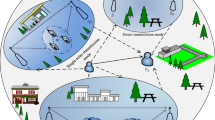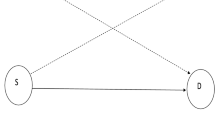Abstract
In this paper, we investigate the performance of different relay selection techniques for Cognitive Radio Networks (CRN). The network contains a primary transmitter \(P_T\), a primary receiver (\(P_R\)), a secondary source and two secondary destinations. In the first transmission phase, the secondary source transmits a signal to the two secondary destinations only when it generate interference to \(P_R\) less than \(\beta \). In the secondary phase, one destination acts as relay and help the other destination. The generated interference by the chosen relay should be less than a prefixed threshold \(\beta \). If the two destinations generate a lot of interference, there is no cooperation. If a single destination generate interference less than \(\beta \), this node acts as relay. If the two destinations generate low interference, we use centralized (CRS), distributed (DRS) or round robin relay selection (RRRS). Centralized Relay Selection (CRS) chooses the relay having the highest end-to-end Signal to Noise Ratio (SNR). In DRS, a relay is chosen if its SNR is greater than threshold T. The value of T is optimized to have the best performance. RRRS activates both nodes with the same probability i.e. 0.5 without using the value of SNR. Most of previous studies dealt with best relay selection for CRN. Our main contribution is to suggest DRS for CRN and to optimize threshold T. We also derive the Bit Error Probability (BEP) of DRS, CRS and RRRS.















Similar content being viewed by others
References
Mitola, J. (1999). Maguire GQ cognitive radio: Making software radios more personal. IEEE Personal Communications, 6(4), 13–18.
Akyildiz, I., Lee, W. Y., Vuran, M. C., & Mohanty, S. (2006). Next generation/dynamic spectrum access/cognitive radio wireless networks: A survey. Computer Networks, 50(13), 2127–2159.
Rini, S., & Hupper, C.(2013) On the capacity of cognitive interference channel with a common cognitive message. Transaction on Emerging Telecommunication Technologies, 1
Alptekin, G. I., & Bener, A. B. (2011). Spectrum trading in cognitive radio networks with strict transmission power control. Transaction on Emerging Telecommunication Technologies, 22(6), 282–295.
Tan, X., Zhang, H., Chen, Q., & Hu, J. (2013). Opportunistic channel selection based on time series prediction in cognitive radio networks. Transaction on Emerging Telecommunication Technologies, 17(3), 32–38.
Haykin, S. (2005). Cognitive radio: Brain-empowered wireless communications. IEEE Journal on Selected Areas in Communications, 23(2), 201–220.
Menon, R., Buehrer, R., & Reed, J. (2005). Outage probabilitybased comparison of underlay and overlay spectrum sharing techniques. In IEEE International Symposium on New Frontiers in Dynamic Spectrum Access Networks (pp. 101–109), Baltimore, November.
Yulong, Z.. Jia, Z., Baoyu, Z., Sulan, T., & Yu-Dong, Y. (2010). A cognitive transmission scheme with the best relay selection in cognitve radio networks. IEEE GLOBECOM.
Chamkhia, H., Hasna, M.O., Hamila, R., & Hussain, SI. (2012). Performance analysis of relay selection schemes in underlay cognitive networks with Decode and Forward relaying. IEEE PIMRC.
Manna, M. A., Chen, G., & Chambers, J. A. (2014). Outage probability analysis of cognitive relay network with four relay selection and end-to-end performance with modified quasi-orthogonal space-time coding. IET Communications, 8(2), 233–241.
Hussain, S. I., Alouini, M.-S., Hasna, M., & Qaraqe, K. (2012). Partial relay selection in underlay cognitive networks with fixed gain relays (pp. 1–5). In VTC Spring.
Hussain, S. I., Alouini, M. S., Qarage, K., & Hasna, M. (2012). Reactive relay selection in underlay cognitive networks with fixed gain relays. IEE ICC (pp. 1784–1788).
Xing, Z., Zhi, Y., Yue, G., & Wenbo, W. (2013). On the study of outage performance for cognitive radio networks (CRN) with Nth best relay selection in Rayleigh fading channels. IEEE Wireless Communications Letters, 2(1), 110–113.
Ubaidulla, P., & Aissa, S. (2012). Optimal relay selection and power allocation for cognitve two way relaying networks. IEEE Wireless Communications Letters, 1(3), 225–228.
Lan, P., Sun, F., Chen, L., Xue, P., & Hou, J. (2013). Power allocation and relay selection for cognitive relay networks with primary QOS constraint. IEEE Wireless Communication Letters, 2(6).
Hussain, S. I., Alouini, M. S., Qarage, K., & Hasna, M. (2012). Best relay selection using SNR and interference quotient for underlay cognitive radio networks. In ICC.
Elsaadany, M., & Hamouda, W. (2017). Antenna selection for dual-hop cognitive radio networks: A multiple-relay scenario. IEEE Transactions on Vehicular Technology, 66(8), 6754–6763.
Onel, L., & Lopez, A. Sanchez, S. M., Mafra, S. B., Fernandez, E. M. G., Brante, G., & Souza, R. D. (2017). Power control and relay selection in cognitive radio ad hoc networks using game theory. IEEE Systems Journal, 1(99), 1–12,
Goel, D., Krishna, V. S., & Bhatnagar, M. (2016). Selection relaying in decode-and-forward multi-hop cognitive radio systems using energy detection. IET Communications, 10(7), 753–760.
Xu, X., & Yang, W. (2017). Opportunistic relay selection improves reliabilityreliability tradeoff and securityreliability tradeoff in random cognitive radio networks. IET Communications, 11(3), 335–343.
Nguyen, M.-N., Nguyen, N.-P., Daniel, B., Costa, D., Nguyen, H.-K., & Sousa, R. T. De. (2017). Secure cooperative half-duplex cognitive radio networks with K-th best relay selection. IEEE Access, 5, 6678–6687.
Lei, H., Zhang, H., Ansari, I. S., Ren, Z., Pan, G., Qaraqe, K. A., & Alouini, M.-S. (2017). On secrecy outage of relay selection in underlay cognitive radio networks over Nakagami-m fading channels. In IEEE Transactions on Cognitive Communications and Networking, PP(99), 1–1.
Lai, X., Xia, J., Tang, M., Zhang, H., & Zhao, J. (2018). Cache-aided multiuser cognitive relay networks with outdated channel state information. IEEE Access, 6, 21879–21887.
Xia, J., Zhou, F., Lai, X., Zhang, H., Chen, H., Yang, Q., Liu, X., & Zhao, J. (2018). Cache aided decode-and-forward relaying networks: From the spatial view. Wireless Communications and Mobile Computing 2018
Simon, M. K., & Alouini, M.-S. (2000). Digital communication over fading channels. New York: Wiley.
Iskander, C. D., & Mathiopoulos, P. T. (2003). Fast simulation of diversity Nakagami fading channels using finite-state Markov models. IEEE Transactions on Broadcasting, 49(3), 269–277.
Lisheng, F., Lei, X., Yang, N., Duong, T. Q., Karagiannidis, K., Duong, Q., et al. (2016). Secure multiple amplify-and-forward relaying with cochannel interference. IEEE Journal of Selected Topics in Signal Processing, 10(8), 1494–1505.
Fan, L., Lei, X., Yang, N., Trung Q, D., & Karagiannidis, K. (2017). Secrecy cooperative networks with outdated relay selection over correlated fading channels. IEEE Transaction of Vehicular Technology, 66(8), 7599–7603.
Shi, F., Fan, L., Liu, X., Na, Z., & Liu, Y. (2018). Probabilistic caching placement in the presence of multiple eavesdroppers. Wireless Communications and Mobile Computing, Article ID: 2104162.
Ikki, S., & Ahmed, M. H. (2007). Performance analysis of cooperative diversity wireless networks over Nakagami-m fading channel. IEEE Communications Letters, 11(4), 334–336.
Author information
Authors and Affiliations
Corresponding author
Ethics declarations
Conflict of interest
On behalf of all authors, the corresponding author states that there is no conflict of interest.
Appendices
Appendix A
When there is cooperation, the SNR at \(D_i\) is the sum of SNRs direct and relayed link
where \(\Gamma _{S,D_{j},D_i}\) is the SNR between S, \(D_{j}\) and \(D_i\) [5]
The MGF of the SNR when there is cooperation is equal to
In order to obtain simple equations, the following lower and upper bounds will be used
We have
Lower bound on BEP In the following, we derive a lower bound of the Symbol Error Probability (SEP) using the above upper bound on SNR.
The MGF of \(\Gamma _{coop}^{up}\) can be written as
where
The CDF is equal to
We have
where
The PDF is obtained by a simple derivative of above equation
A Laplace Transform (LT) of the PDF gives the MGF (Moment Generating Function) [30]
where \(_{2}F_{1}(.,.,.)\) is Gauss’ hypergeomeric function defined in [25].
Upper bound on BEP
We explain how we can easily plot an upper bound of the SEP using the above lower bound on SNR.
Let \(Y=\Gamma _{S,D_{j},D_i}^{low}\) and \(X=\Gamma _{S,D_{j},D_i}^{up}\). We have Y=X/2. Therefore, the CDF, PDF and MGF of Y can be deduced from the following simple equations \(P_Y(u)=P_X(2u)\), CDF \(p_Y(u)=2p_X(2u)\), PDF \(M_Y(s)=E(e^{-sY})=M_X(s/2)\), MGF
Therefore, the MGF of the lower bound of SNR is given by
Appendix B
The derivative of function A(T) is given by
Rights and permissions
About this article
Cite this article
Ben Halima, N., Boujemâa, H. Round robin, distributed and centralized relay selection for cognitive radio networks in the presence of Nakagami fading channels. Telecommun Syst 70, 405–415 (2019). https://doi.org/10.1007/s11235-018-0505-6
Published:
Issue Date:
DOI: https://doi.org/10.1007/s11235-018-0505-6




